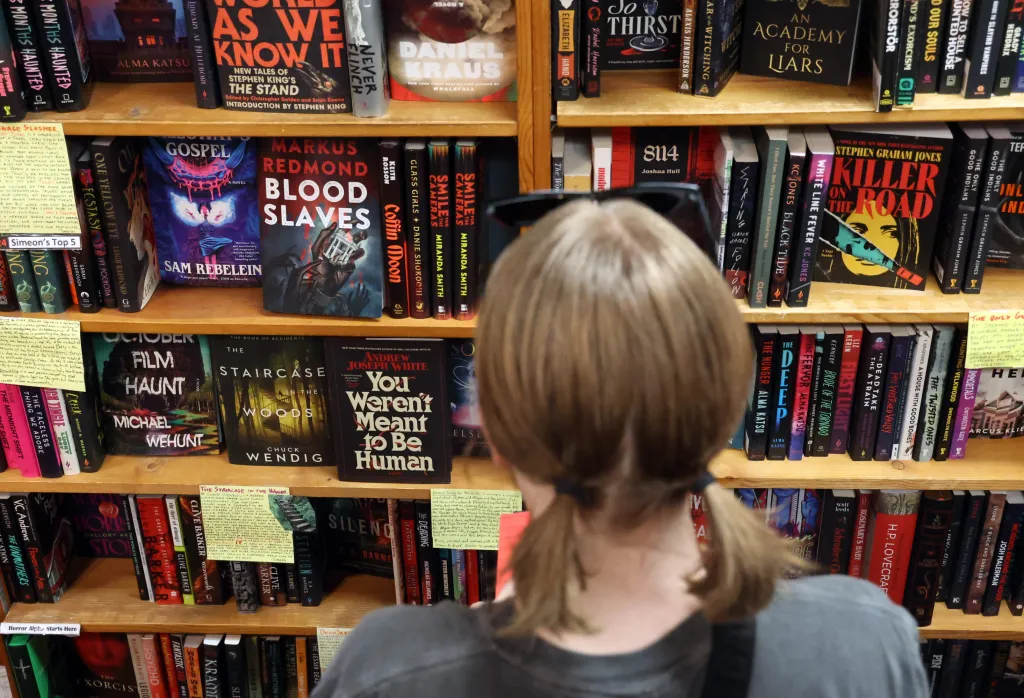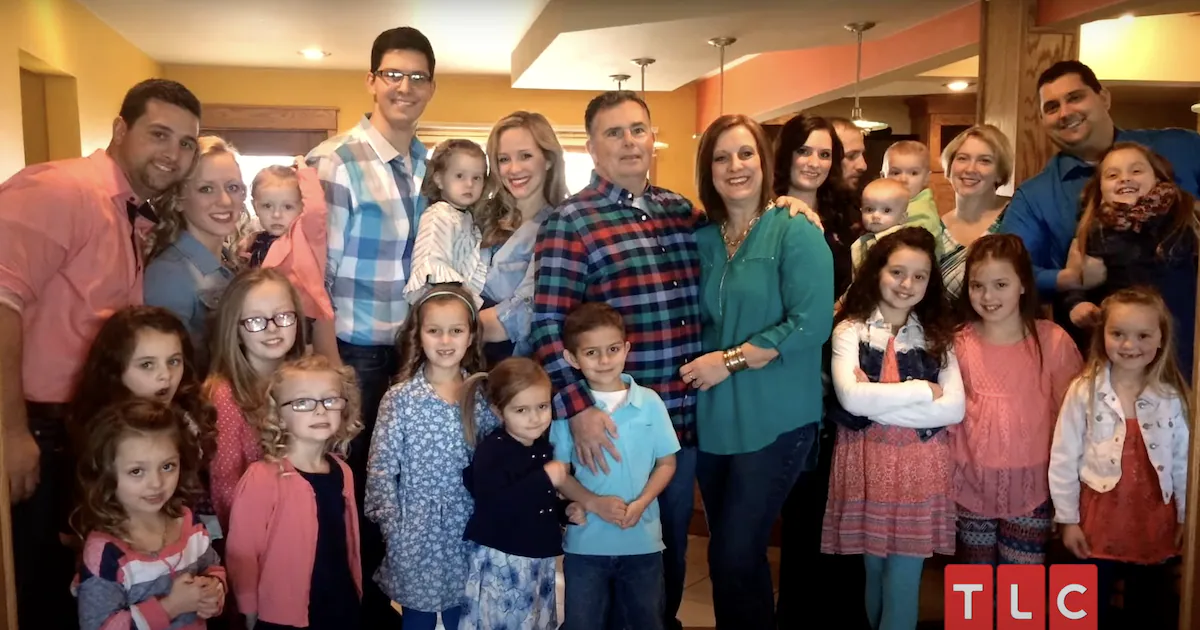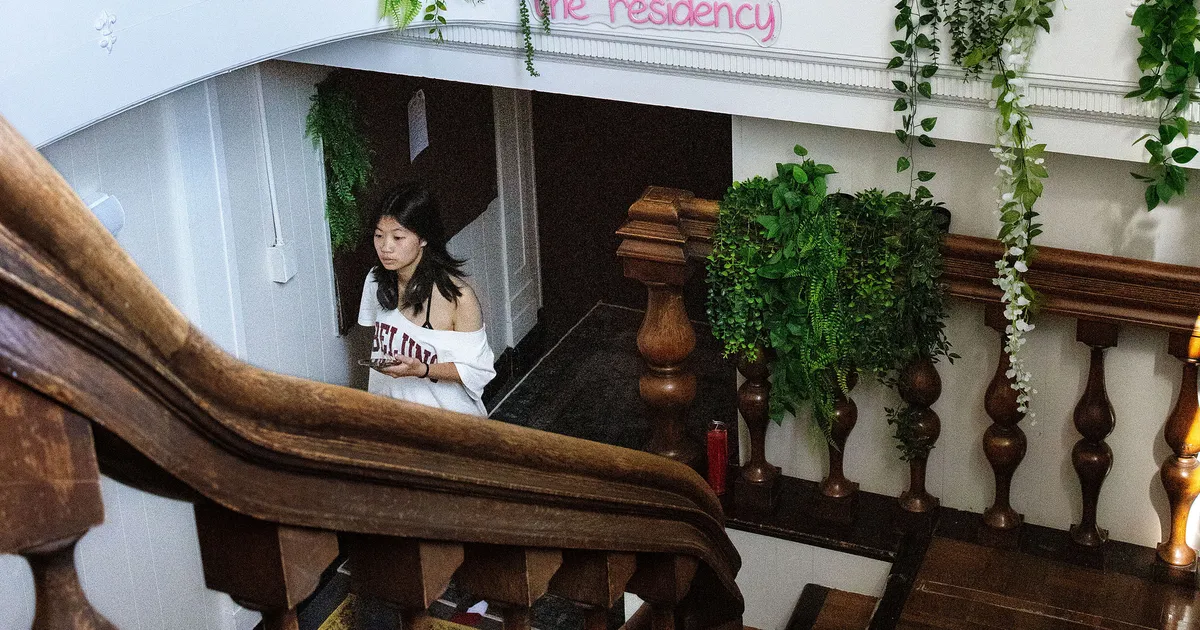
We hold these fears to be self-evident:
Go outside alone to see what’s making that noise, that weird skittering, metallic scratching, and you won’t be returning to your couch. Answer your phone at 3:30 in the morning and someone died or someone’s calling from beyond the grave. The folks in the small town you’re passing through are not who they appear to be. But most of all, there is no way to discuss what’s new and worth reading during spooky season without summoning Stephen King, Maine royalty, the sum of all fears. Horror literature begins and ends with him. You shall not pass. I know, Tolkien. But still, no, you shall not.
We always welcome the annual, ahem, return of the King.
We’ve lived under his cloud — his addicting, diabolically clever cloud that grows only larger, never retracting — for 50 years. King’s first novel, “Carrie,” was published in 1974, and it did… OK, perfectly fine for a debut author. It wasn’t until 12 months later, when “Carrie” hit paperback and became a sensation, did that long, prolific career really begin.
Fifty years on, a disproportionate amount of my reading time is filled with the literary children of King, literary fiction dripping with elements of horror or myself raving like a lunatic about contemporary horror novelists. Fifty years on, if you’re looking for fiction to capture what ails the 21st century, the genre’s hard to avoid. It’s like finding a new room in an old house, stocked with a wonderful pestilence. Four of the smartest books of the year are comfortably uncanny; none are by King. That’s how rich horror lit has become. Stephen Graham Jones, of the Blackfeet Tribe of Montana, among the marquee names of contemporary horror, uses vampires to trace a century of Native American social justice in “The Buffalo Hunter Hunter.” Virginia Feito’s “Victorian Psycho” rips the dormant tradition of literary antiheroes from Bret Easton Ellis and returns to the gothic shores of Patricia Highsmith. “The specimen is breathing” — that’s how Sarah Gailey opens “Spread Me,” pioneering a provocative route for sex and contagion to coexist, drawing on John Carpenter’s “The Thing” and 19th century viral terrors of Bram Stoker.
John Langan, a former college professor from upstate New York, whose books have been published mainly by small independents, whose tales always come bundled between the ugliest of pulp covers, is, as far as I’m concerned, as playful and surprising and sophisticated a weirdo as Herman Melville: “Lost in the Dark and Other Excursions,” his new collection, disregards genre expectations, delivering on the breath of possibility absent in a lot of contemporary fiction, spinning sea tales and literary almost-satires and riffs on Mary Shelley that don’t just rework “Frankenstein.” There’s a dabble of surrealism in here about a gecko who returns from the dead to prophesize, and it’s so alternately funny and chilling you can almost hear Langan giggling behind the laptop.
Horror lit, maybe you’ve heard, is in an unprecedented renaissance of quality, partly driven by an explosion of novelists of color, women and nonbinary writers; partly driven by newly dedicated horror sections in bookstores; partly driven by a proliferation of horror-only book clubs (there are at least three in Chicago). And partly driven by the world itself: You’re scared of what we’re becoming.
I’m scared of it, too. Horror thrives on that.
Typically, we think of movies as reading the collective room and mirroring current anxieties; and yes, it shouldn’t be a shocker that arguably the two most critically and financially successful films of 2025 so far, “Sinners” and “Weapons,” are firmly in the horror tradition. But horror lit is so voluminous and vibrant now there’s even a new book to explain why horror itself is having a moment: “Morbidly Curious: A Scientist Explains Why We Can’t Look Away,” by Coltan Scrivner, is predictably wonky, yet insightfully counterintuitive, showing how horror audiences can be generally empathetic, explaining the benefits of “scary play” for children. He’s particularly good at illustrating the science of why Halloween and the softer side of horror can be perversely cozy. Indeed, reading John Hornor Jacobs’ “The Night That Finds Us All,” in particular, I could feel myself grinning, tucking my legs under myself, burrowing in with delight at descriptions of the book’s creaking haunted schooner, the way its crew enters at the “mouth,” a vessel “unmoored from the currents of time, lost in a far-flung future.”
My response is a reminder, Scrivner might say, of facing something scary as a child, of having edged close to a terrible line and survived, emerging exhilarated. Similarly, Chicago author Christina Henry’s “The Place Where They Buried Your Heart” (Nov. 4) might play as merely a haunted house story. But if you’re from Chicago, you’ll realize this house is near Wrigley Field. Its weathered facade is refusing to be demolished. Its walls devour visiting gas company workers. Despite its history, neighbors won’t leave — “their adult lives had been spent in the shadow of thing.” They have seniority. Even if they die, at least one building here will never be owned by the Ricketts.
The genre wasn’t always this robust.
As much as I love Stephen King and dutifully read each new book — he’s as cozy now as a haunted chez lounge — I sometimes felt he had ruined horror lit for me. I thought that as a teenager, when I would plow through two or three of his books from the library, then grow starved for months, not finding anything else as smart or scary. The problem seemed, once you sought out Shirley Jackson and Peter Straub and the ghost stories of M.R. James and read the original “Dracula” and Ray Bradbury’s “October Country,” you stalled. As with mystery novels or sci-fi, the pool can look extremely shallow and cluttered with junk. You read something as auspicious as the opening of Jackson’s “The Haunting of Hill House” — “Hill House, not sane, stood by itself against its hills, holding darkness within” — and assume there’s a treasure chest of classics still left to discover.
What I eventually realized was that we had to wait for generations for King’s promise to bear fruit. Now you can hear echoes of King everywhere in horror lit, sometimes as broad homage, more often in the colloquial snap of the dialogue, the nods to fast food and literature and slasher movies and regional lore. “The Whistler” by Nick Medina, a native of Chicago and a member of the Tunica-Biloxi Tribe of Louisiana, is rooted in the Native American myth that a curse will follow when someone whistles at night. But the meat of his prose is a protagonist high on hubris, a social media ghost-hunting star who becomes a quadriplegic and suspects he’s being stalked by his own history of questionable behavior. Shades of “Misery,” and others. “Widow’s Point,” by Richard Chizmar and son W.H. Chizmar (who dedicate the novel to King), a ghost story in a Maine lighthouse, leans into Kingian haunts, a jack-o-lantern face growing wider, maniacal mannequins, the cuddle of its coastline rusticity, its “rough stone walls faded and worn from years of tumultuous weather and neglect.” Nat Cassidy’s “When the Wolf Comes Home,” likewise, plays explicitly like high-concept ‘80s King, a “Twilight Zone” episode meets “Firestarter.” You can see the movie. It’s much breezier than contemporary horror: a father, who may be a werewolf, hunts a 5-year-old, who can create anything he fears.
My favorite quasi-Kingian book is “Acquired Taste: Chilling Stories,” by Clay McLeod Chapman, whose excellent shorts recall the winking audacity of King’s stories, as well as a similar talent for titles: “Who Brings a Baby?” is a brief sketch about a man in a theater, bugged by a mewing infant, who feels something scuttling at his feet; “Nathan Ballingrud’s Haunting Horror Recs” charmingly recasts real horror author (a cult favorite within a genre of cults) as a bookstore employee who leads customers to exactly what I once wished for, a never-ending well of amazing untapped horror lit. The problem, naturally, is you get turned around in this store and potentially never leave.
“All roads lead back to the King,” Chapman writes in his essay for “Why I Love Horror,” a new collection of essays edited by Becky Siegel Spratford, a reader’s advisory specialist and a fixture of libraries throughout the Chicago suburbs. A tireless proponent of new horror, she rounded up a who’s-who of practitioners. For example, Rachel Harrison — whose latest, “Play Nice,” brings the sarcastic knowing snap of early 2000s Lindsay Lohan movies to a haunted house epic, and that’s not a bad thing — writes she thought she felt things “too intensely” to get into horror, but decided “that’s exactly why horror is for me.” She also read a lot of Stephen King. They all do. Chicago author Cynthia Pelayo — whose blending of Chicago crime history and fairy tales and horror is having a breakout year — writes in “Why I Love Horror” about recognizing her Humboldt Park childhood in King’s “Carrie.” Her essay, “My Mother Was Margaret White,” plainly relates her own mother to Carrie’s abusive, religiously fanatical mother.
“Horror,” Pelayo writes, “teaches me that there is an end, and that there is peace.”
Her contribution to another new collection, “Red Line: Chicago Horror Stories,” considers Chicago the ideal playground for horror stories, as right as King’s Maine, terrible and lovely at once: “We are above and we are below.” If there’s a thread through the 18 pieces that follow, it’s You-can’t-talk-smack-about-my-mother-that-way-only-I-can-talk-smack-about-my-mother-that-way. Lauren Emily Whalen’s “Just Another Friday Night in Bucktown” is a lash against sexual abuse in a vibrant storefront theater community. A love-hate impulse curls through others. The Chicago River is essential; the Chicago River holds monsters. Lower Wacker is for locals; Lower Wacker is hell.
What’s brought contemporary horror back from the dead, in part, what not even King’s practiced enough, is horror as social allegory. “You Weren’t Meant to Be Human” is not just Andrew Joseph White’s Appalachian gross-out with worm aliens running a hive while the world collapses; it’s an unapologetic portrait of trans lives struggling with bodily autonomy. Alma Katsu’s “Fiend” is not just a clever redo of “Succession” with Faustian bargains; it’s about 21st century capitalism as a literally inbred pestilence. The Black experience in overwhelmingly white spaces plays at the edges of Kosoko Jackson’s “The Macabre” (cursed paintings in the art world) and Quan Barry’s “The Unveiling” (a Black location scout for movies finds herself stranded with white tourists in the Antarctic). Set in 17th century Europe, “The Wax Child,” by Danish novelist Olga Ravn, is a rare witchcraft tale that doesn’t portray power as merely about the strong against the weak. In nonfiction: Zefyr Lisowski’s “Uncanny Valley Girls: Essays on Horror, Survival and Love” refashions “The Ring” and “Scream” and more as studies in identity. More potent is Eleanor Johnson’s “Scream With Me: Horror Films and the Rise of American Feminism (1968-1980),” which argues convincingly for “Alien,” “The Shining” and “Rosemary’s Baby” as byproducts of abortion politics and domestic abuse.
If you’re having a hard time these days relating to your fellow neighbor, it’s hard not to see an insular, frightened contemporary America in “Burnt Sparrow: We Are Always Tender With Our Dead”: Eric LaRocca’s at-times masterful homage to Shirley Jackson. It opens with dozens of New Hampshire citizens massacred on a small town street, and the casual order from town leaders to leave them in the street and carry on. Same vibe, but more accomplished: Neil Sharpson’s “The Burial Tide,” about a woman who crawls out of her own grave to find a surprised island Irish village collectively gaslighting her.
Horror’s best subject, though, has always been time, the violence of change.
It’s King’s best subject, too.
Echoes of “It,” “Salem’s Lot” and “11/22/63” creep through the year’s best new horror: Chuck Wendig’s “The Staircase in the Woods” catches up a group of friends decades after one ascended the cosmic titular threat and vanished; Keith Rosson’s “Coffin Moon” is a post-Vietnam war, dive-bar ‘70s vampire story with a rebellious teen eager to move on; “Old Soul” by Susan Barker spins a female vampire across continents and centuries and is less a thriller than a lovely consideration of loneliness. Joe Hill, King’s oldest son, a smart horror writer himself, returns with a Kingian doorstop: “King Sorrow” tells the story of friends who make a deal with an otherworldly dragon to provide the beast with a fresh kill every Easter, or they will be killed themselves. What sounds manageable (in a relative way) when you’re young festers as the years accumulate. Dan Chaon’s “One of Us” places us inside a circus freak show traveling through the Midwest of 1915 and staring into the inevitable end of a way of life, making stops at Carl Sandburg and Ray Bradbury.
You know what pales in comparison?
Enthusiasm for horror itself, ironically. Josh Malerman, the Michigan author of “Bird Box,” meanders through “Watching Evil Dead: Unearthing the Radiant Artist Within”; Wayne Byrne’s “You Can’t Kill the Boogeyman: The Ongoing Halloween Saga” offers little insight about a franchise approaching 50 years of movies.
There is an exception.
And that is, digging through the graves of influences, turning over their skulls, recognizing your roots in their dirt. King himself does this in a warm appreciation to “After Midnight,” a new collection of spooky tales from Daphne Du Maurier, best known as the source of Alfred Hitchcock’s “Rebecca” and “The Birds.” He nails her sweet spot as describing the worst possible scenario with “a calm rationality that makes them nightmare fuel.” A similar love is evident in “The End of the World As We Know It: New Tales of Stephen King’s The Stand.” Thirty-eight contemporary writers, King’s literary children, gather in one place, to tinker around in his sandbox. They don’t imitate so much as continue what he started. It’s a mountain of a collection, nearly as large as the 1978 original. The nice thing is that, from here, you can see the past and the future.
cborrelli@chicagotribune.com



